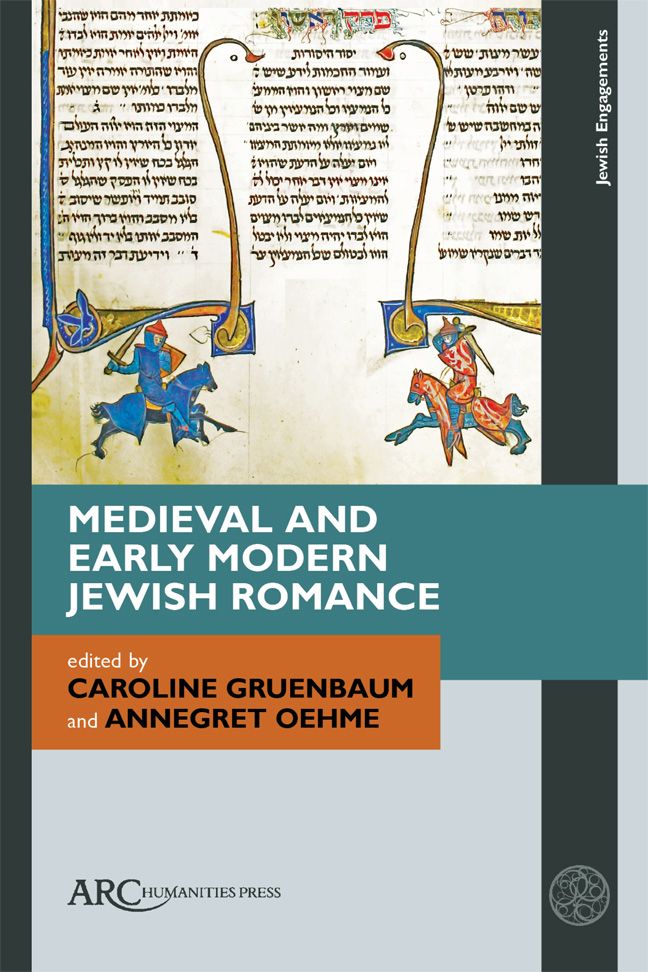Book contents
- Frontmatter
- Dedication
- Contents
- List of Illustrations
- Acknowledgements
- Introduction
- The Zohar as Medieval Jewish Romance
- Letters of Loathing: Immanuel of Rome and Romance Epistolary
- Illuminated Knights and Tales of Romance in the Rothschild Miscellany
- The Queen Nudatio: A Romanesque (?) Topos in Israel Caslari's Roman d’Esther
- At the Court of the Demon King: The Story of the Jerusalemite and Chivalric Romance
- Melekh Artus as a Jewish Romance: Horizons of Expectation and Genre Configurations
- A Friend in Need is a Friend Indeed?Friendship, Love, and Loyalty in the Yiddish Seven Sages of Rome
- Stealing Back One's Husband: The Yiddish Mayse mi-Danzek in the Context of Early Modern German Cross-Dressing Narratives
- Romance Elements in Meshal Haqadmoni by Isaac Ibn Sahula: A New Reading
- Afterword: Jewish Romance in Search of Identity
- Select Bibliography
- Index
Illuminated Knights and Tales of Romance in the Rothschild Miscellany
Published online by Cambridge University Press: 18 February 2024
- Frontmatter
- Dedication
- Contents
- List of Illustrations
- Acknowledgements
- Introduction
- The Zohar as Medieval Jewish Romance
- Letters of Loathing: Immanuel of Rome and Romance Epistolary
- Illuminated Knights and Tales of Romance in the Rothschild Miscellany
- The Queen Nudatio: A Romanesque (?) Topos in Israel Caslari's Roman d’Esther
- At the Court of the Demon King: The Story of the Jerusalemite and Chivalric Romance
- Melekh Artus as a Jewish Romance: Horizons of Expectation and Genre Configurations
- A Friend in Need is a Friend Indeed?Friendship, Love, and Loyalty in the Yiddish Seven Sages of Rome
- Stealing Back One's Husband: The Yiddish Mayse mi-Danzek in the Context of Early Modern German Cross-Dressing Narratives
- Romance Elements in Meshal Haqadmoni by Isaac Ibn Sahula: A New Reading
- Afterword: Jewish Romance in Search of Identity
- Select Bibliography
- Index
Summary
THERE ARE FOUR scenes displaying knights in the Rothschild Miscellany (Jerusalem, Israel Museum, MS 180/51), produced in Northern Italy in 1470–1480 (Figs. 1–4). The volume, which has 473 folios and measures 21 by 15.9 cm, was commissioned by Moshe ben Yekutiel ha-Kohen, probably of Ashkenazi origin, and copied by Shabbetay the scribe. It includes thirty-seven different texts—some in the centres of the pages and some in the margins—and many illuminations. Scholars still debate about the workshops where the illuminations were produced, but they all agree that it was produced in Northern Italy. The texts bound together include biblical and liturgical works; rabbinic exegeses (Midrash); texts on Jewish law, ethics, philosophy, and astronomy; historical legends such as Sefer Josippon; the Passover Haggadah (guide to the Passover seder); and the fable book Meshal haQadmoni. In this essay, I refer to images of three knights dressed in Italian armour in four scenes: Sisera on fol. 164v (Fig. 1), Judah the Maccabee on fol. 217r (Fig. 2), and two scenes of the same character from a fable in Meshal haQadmoni on fols. 320v and 321r (Figs. 3–4). I start by contextualizing the manuscript and then relate to each scene and its textual context, focusing primarily on the scene from Meshal haQadmoni. In this preliminary essay, I ask some questions that may better help us understand the ways in which the themes of knights and romance are reflected in fifteenth-century Hebrew manuscripts.
Romance and Jewish Chivalry
The aesthetics of warfare expressed in tournaments, portrayals of aristocracy, nobility, and chivalric symbols was a ubiquitous motif in medieval European Christian literature. This genre includes instruction books, such as such as Ramon Llull's Llibre qui es de l’ordre de cavalleria, as well as romances; some of the latter were actually written by knights so they paint a more accurate picture of the knightly life and mindset than we find in the instruction genre. A Christian warrior's or knight's arms and armour signaled his rank in the feudal hierarchy. Aristocratic symbols marked the difference in status between noblemen from birth and warriors who, through engaging in combat, could earn their knighthoods, but peasants were not allowed to carry swords or lances. Throughout this essay, I emphasize that the characters discussed here are not necessarily knights of noble birth, but could be warriors.
- Type
- Chapter
- Information
- Medieval and Early Modern Jewish Romance , pp. 49 - 72Publisher: Amsterdam University PressPrint publication year: 2023

